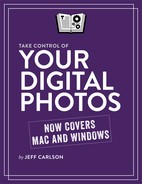Import Your Photos the Smart Way
Moving photos from a camera or memory card to the computer seems like mere transportation: bits captured and stored in one location are copied and saved to a new location. That sounds about as exciting as bringing groceries home from the market.
But what if those groceries could assemble themselves into prepared meals by the time you delivered them to your kitchen? And what if your photos could organize themselves on the way to your disk by detailing what’s in each image, where it was shot, and by whom?
Your computer can do more than just shuttle files from one location to another. By taking advantage of software’s capability to assign metadata during the import stage, much of the drudgery of organizing photos is handled upfront with minimal interaction required by you. And, you may also be able to set up your import such that you Choose Where Files Will End Up.
Apply Metadata at Import
Computers were designed for grunt work, whether that’s decrypting World War II ciphers or batch-applying keywords to hundreds of photo files in one go. Yes, you can always manually add metadata later, but will you, really? Maybe for a few terms here and there (which is inevitable, and useful, as I cover in Assign Keywords and Other Metadata), but probably not for all the images in a shoot.
Spending a tiny amount of time optimizing the import process—especially in applications that support metadata templates—gives you a tremendous advantage when locating photos down the line after you’ve moved on to the next batch of shots.
Specifically, what items are we talking about? In Lightroom Classic (and Photoshop Elements in a limited way), you can apply the following metadata during import:
Keywords: Apply any descriptive terms for this set of photos that you are likely to search for later, such as the name of an event or landmarks that appear. For accuracy, include only keywords that apply to all the images being imported.
For example, if I’m importing 100 photos of trains and my friend Mark Smith appears in 30 of them, I would not include the keyword
marksmithduring the import process. It’s better to add the tag to those 30 shots later than to do a search for “mark smith” at some point and turn up 70 images that don’t contain Mark. It’s also easier to add new terms later than to dig out errant ones.IPTC metadata: If IPTC presets didn’t make it so easy, I’d likely never assign this identifying information to my photos. (IPTC stands for International Press Telecommunications Council, the group that established this model of assigning uniform metadata.) Many of the fields are specific to industries or projects (IPTC Subject Code, Intellectual Genre) but basic fields such as Creator, Contact Email, and Copyright Notice are useful to anyone. If you need to submit the file somewhere, such as a file-sharing site, that information stays with the file (and can be useful for identifying ownership if someone swipes it when they shouldn’t).
Caption: I use this to include contextual information that applies to every shot I’m importing, such as “California Science Center” or “Family Vacation 2017,” knowing that it will show up when friends and family view the images I upload to social media sites.
Rating: In Lightroom Classic, you can assign a rating for everything, such as giving each photo one star (I explain the reasoning behind this in Judge Your Photos).
Since some of this information—such as IPTC fields—typically remains the same from shoot to shoot, the best method of applying it is to create presets that fill in the data for you when the images are copied to your computer. You gain the benefit of valuable metadata without having to deal with it manually each time. Remember that this information is just a baseline—you can add specific keywords and other data in the import window before you begin the transfer.
Lightroom Classic
Let’s look at an example of how this works by creating a new preset in Lightroom Classic:
Choose Metadata > Edit Metadata Presets. A dialog appears with fields for the metadata that Lightroom supports (Figure 18).
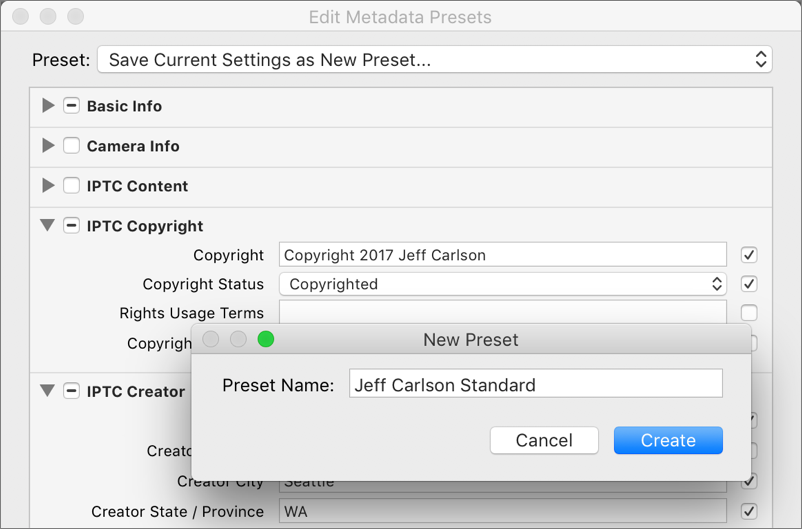
Figure 18: Creating a new metadata preset in Lightroom. Fill in the fields you wish to be applied to the imported images.
From the Preset pop-up menu, choose Save Current Settings as New Preset.
Enter a name for the preset, and click the Create button.
Click Done to exit the dialog.
In Lightroom’s Import window, expand the Apply During Import panel and choose your new preset in the Metadata field (Figure 19).
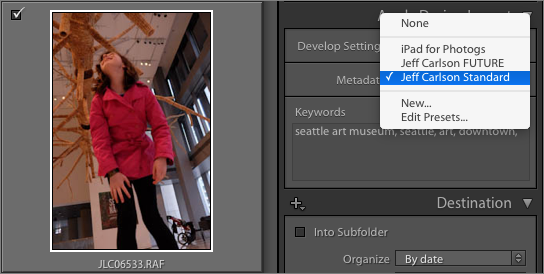
Lightroom CC
The import process in Lightroom CC is deliberately scaled down compared to Lightroom Classic, which is good for people who feel overwhelmed by all the options in Classic, but is disappointing for our needs. You can choose which photos to import, and optionally assign them to an album.
However, you can sneak some metadata through the back door, after import:
Import a set of photos from your camera. They’re collected in a Recently Added category, which you can view by clicking the My Photos
 button (or pressing the P key) to view the My Photos panel (Figure 20).
button (or pressing the P key) to view the My Photos panel (Figure 20).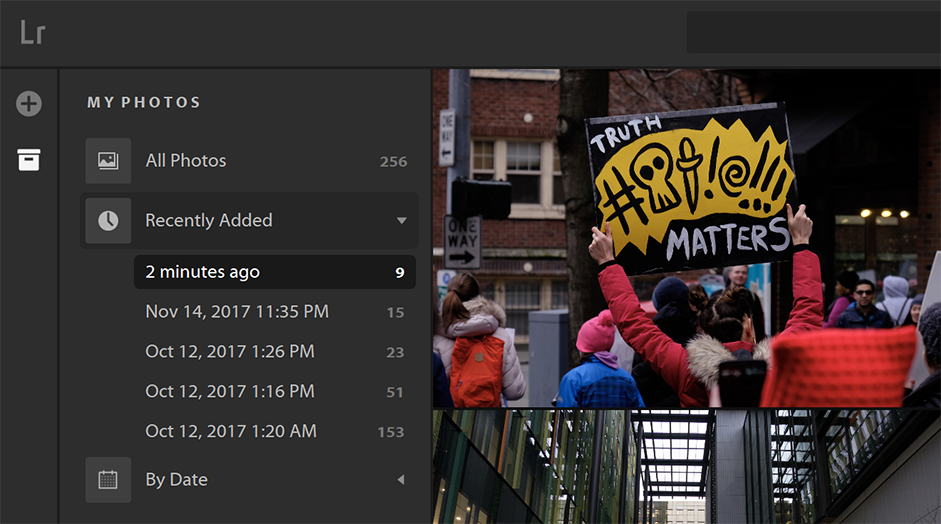
Figure 20: Lightroom CC displays your most recently imported images in this special category. Choose Edit > Select All.
Open the Keywords panel by clicking the Keywords
 button, or pressing K.
button, or pressing K.Type keywords that apply to the entire selection into the Keywords field (Figure 21).
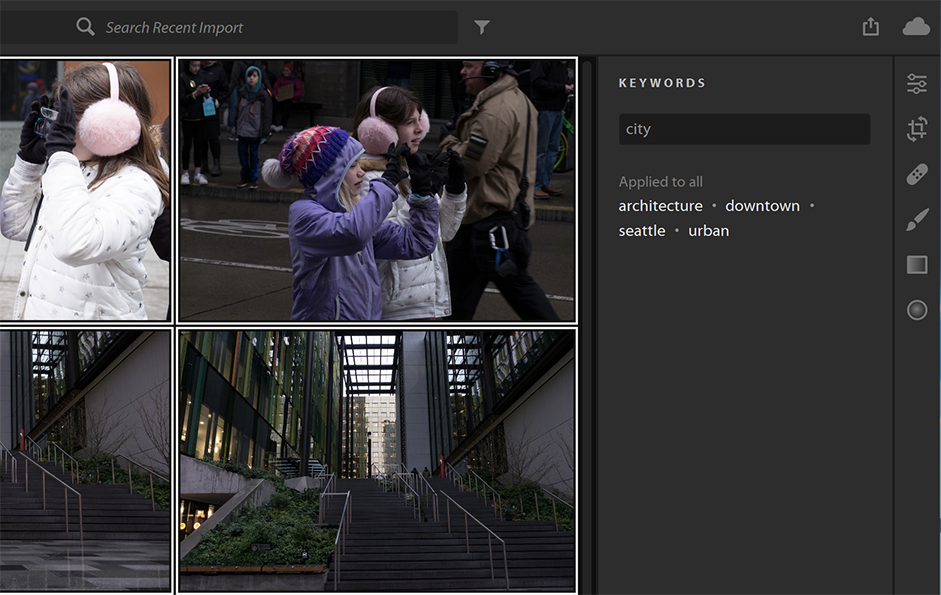
Figure 21: The Keywords panel is sparse, but it’s a good step nonetheless. Next, open the Info panel by clicking the Info
 button, or pressing the I key.
button, or pressing the I key.With all of the photos still selected, enter any metadata that will be shared by all the images, such as caption information, copyright, and location. The data is applied to all of the photos.
Photos for Mac
Photos offers no opportunity to apply any metadata during import. You can import all photos from a camera or memory card or you can select some to import. It pays attention only to the times the photos were captured.
You’re not entirely out of luck, though. After the files transfer to the computer, Photos displays them together in the Last Import album, giving you an opportunity to quickly batch-apply metadata after import. Select all the photos (press ⌘-A), choose Window > Info (or press ⌘-I) to reveal the Info window, and enter keywords and location data (if it applies) (Figure 22).
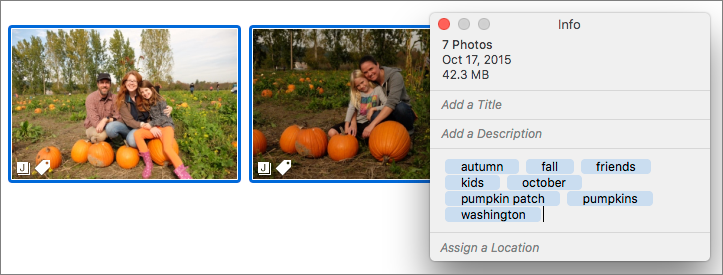
Photoshop Elements
Photoshop Elements has metadata presets, too, but good luck with stumbling upon how to create them. The Import window in the Elements Organizer application (the component of Elements that manages your library) includes only a pop-up menu for choosing presets, not a way to actually create them.
Here’s the skinny:
Launch the Photoshop Elements Editor application (not the Organizer), and then open any image.
Choose File > File Info.
In the dialog that appears, enter the metadata you want to include.
Click the first pop-up button at the bottom of the window (to the right of Preferences; the name depends on what was last selected), and choose Export.
Give the preset a name and click Save.
Click OK to close the dialog and apply the metadata to the open image.
To apply the preset during import in the Organizer, choose File > Get Photos and Video > From Camera or Card Reader. Click the Advanced Dialog button to reveal all the import settings, and then choose the preset that you created from the Template to Use pop-up menu under Apply Metadata.
I know, the process is kind of ridiculous, but once the template is set up it will save you the trouble of applying that information later.
Choose Where Files Will End Up
One of the core ideas behind some applications—including Photos for Mac—is that the software handles the organization for you. All imported photos are stored in one location on disk, and that location appears as a single library file. The notion is that you shouldn’t need to care where the actual image files are, because you’re interacting with the photos within the software.
That approach isn’t terrible. However, it does have a couple of problems. One, photos continue to take up vast quantities of disk space at a time when many hard disk capacities are shrinking. Laptops and even desktop computers are moving to solid-state drives (SSDs), which offer fantastic performance but are still relatively short in the storage department. That means you need to split your library into pieces or relocate it to an external disk.
Two, the fact that you’re reading this book means you’re not a photographic beginner, which means you don’t necessarily need software to hold your hand every step of the way. I’m not suggesting you need to be able to field-strip a laptop blindfolded and build your own OS kernel, but you probably want more control over where the software is putting your files.
For example, Lightroom Classic on my machine saves files in a sensible way, stored in my user folder at ~/Pictures/[Year]/[Year]-[Month]-[Day]/. A photo named IMG1234.JPG captured on July 4, 2016, can be found at ~/Pictures/2016/2016-07-04/IMG1234.JPG. If Adobe were to cancel Lightroom today and make it stop working (if Adobe had some black-helicopter, joy-hating division, I suppose), I could easily traverse my photo library or point another application at it without extricating the files from the package folder.
When possible, take advantage of the capability to specify where imported files will end up. This will give you more flexibility in how you deal with large libraries and archives. For example, on my computer, a MacBook Pro, imported photos are stored on a 1 TB internal hard disk, even though the bulk of my photo library exists on an external drive. If I take my laptop to a coffee shop to work, the most recent imported photos are available for editing. And then, every month or so, depending on how many photos I’ve shot and how much free space is available on the internal disk, I move the older photos to the large external disk. (I do that within Lightroom Classic so the software keeps track of where the files are located.)
Lightroom CC is even better in this regard. You can specify that your local original image files are stored on an external hard disk, and Lightroom CC keeps track of them. If you disconnect that disk—let’s say you take your laptop and head off on a photo adventure—and then import new photos to the laptop while you’re away, those fresh originals are automatically copied to the external disk the next time you connect it; the photos are also copied to Creative Cloud in the interim.
Most applications, other than Photos for Mac, give you the option of choosing where files from the camera or memory card will be saved.
Change Where Lightroom Classic Stores Synced Photos
The capability to sync photos between Lightroom Classic and Creative Cloud is something of a bolted-on feature. When you import photos into Lightroom Classic and synchronize them (by putting them in a collection that syncs to the cloud), Lightroom generates a low-resolution version called a smart preview that gets sent to Lightroom Mobile apps on iOS and Android devices (as well as Lightroom CC if you’re using both desktop applications).
But what about the images you import into those devices first? They’re automatically synchronized to Lightroom Classic via Creative Cloud, but Adobe chose to put them in a special location, separate from where images that are imported directly into Lightroom Classic are stored: a file called Mobile Downloads.lrdata (on the Mac it’s a package file; under Windows it’s a folder). If you want all your images to use the same folder structure—for instance, you want all photos captured on a single day to appear in the same folder—you need to instruct Lightroom Classic to do so.
Open Lightroom Classic’s preferences and click the Lightroom Sync tab. Under Location, enable “Specify location for Lightroom CC ecosystem’s images,” and choose the same directory you use for images you import directly into Classic (Figure 23). Make sure the “Use subfolders formatted by capture date” option is also enabled and set to mirror the same structure that Lightroom uses (year/year-month-day).
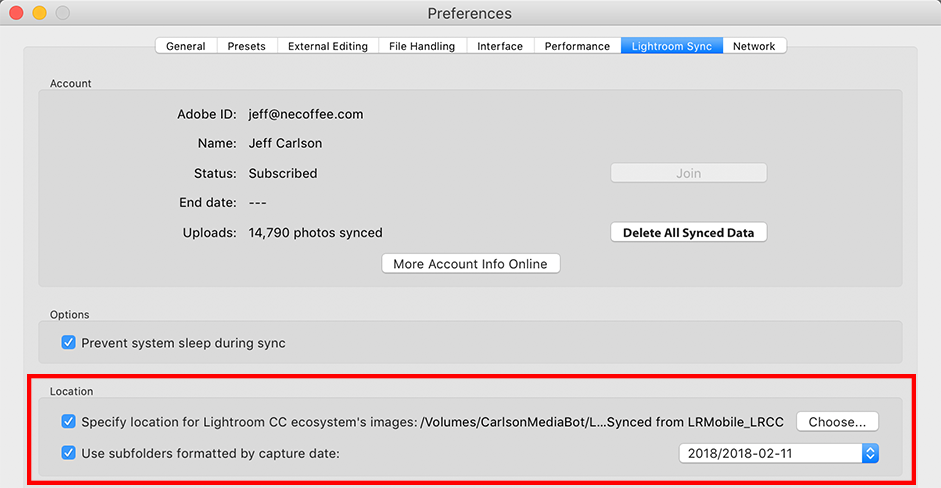
When you click OK, the images previously synced to Lightroom Classic won’t be moved automatically, so you’ll need to drag them manually from the Imported Photos folder (within Lightroom) where they reside to the preferred Lightroom location.
If you want to be thorough, you can create new folders for every date that’s represented. I settled on a compromise: I dumped all of these into a Mobile Downloads folder for that year (by dragging them within Lightroom, remember). Any new images you sync via Lightroom CC on mobile devices or on the desktop will appear in the location you set.
Make a Backup During Import in Lightroom Classic
Another file-related option is to automatically make a backup copy of each image to a separate location during the import process (Figure 24). This feature is good for creating immediate backups while you’re in the field (to a portable hard disk, for instance) or other specific uses. I don’t use this feature for general backups, however; I prefer to stick with a holistic backup system (see Back Up Your Photos).
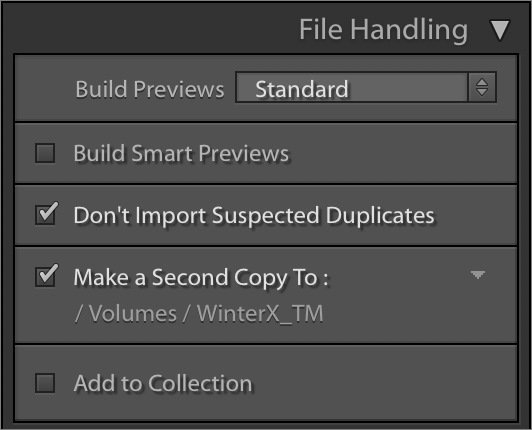
Given that this is a book aiming to make photo management easier, I understand that it sounds like I’m saddling you with a lot of work—you’re no doubt eager to import your photos quickly and start working with them! But applying this metadata at the start of the process, especially by setting up templates to automatically fill in the basics, reaps benefits later.
